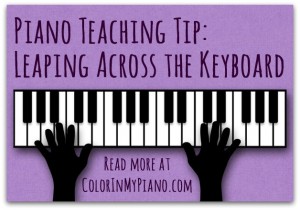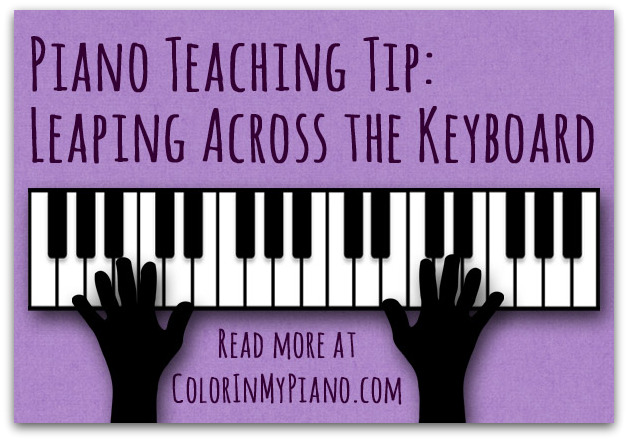 Even from the beginning, the pieces in most modern piano method books require the student to move around the keyboard quite a bit. Older piano methods (at least, the ones that utilize the Middle C reading approach) require the student to stay around the middle of the piano during the entire first level, or even further in some cases. I’m glad modern methods require the student to move around the keyboard, because this because it helps student become familiar and comfortable with the whole keyboard from day one instead of inadvertently teaching the student that anything away from the middle of the piano is “hard.”
Even from the beginning, the pieces in most modern piano method books require the student to move around the keyboard quite a bit. Older piano methods (at least, the ones that utilize the Middle C reading approach) require the student to stay around the middle of the piano during the entire first level, or even further in some cases. I’m glad modern methods require the student to move around the keyboard, because this because it helps student become familiar and comfortable with the whole keyboard from day one instead of inadvertently teaching the student that anything away from the middle of the piano is “hard.”
I’ve had parents notice and comment on this difference between older and newer methods. They are surprised when their student needs to use the whole keyboard at their first lesson, because when they took lessons as a child, they remember playing around Middle C and never venturing to the extreme ends of the keyboard.
As an example: The first four pieces in the Primer Level of the Faber Lesson Book require the student to play a simple pattern on the black key group of 2 or 3, and then to repeat the pattern twice, moving up an octave each time. Other pieces throughout the series require students to play notes up or down an octave, especially at the end of the piece. Other method books take a similar approach.
Often, to the student, making those leaps across the piano is the most challenging aspect of a piece. They sometimes need to stop to think about where their hand needs to go. Even if they know where their hand needs to go, they still might take some extra time searching the keyboard with their fingers to put the correct finger on the correct key. This, of course, disrupts the rhythm of the piece.
How can we help students solve this problem?
When solving even the simplest of problems with students during the lesson, my goal is always to teach them concepts that they can carry with them to move advanced music later in their studies.
When it comes to leaps across the keyboard, it breaks down to this: Let the mind lead the eye, and the eye lead the fingers. When a leap is made incorrectly or inefficiently, usually, one of those two steps went wrong.
- “Let the mind lead the eye…” — This means that the student must first know where they are moving to. If they have to figure out the name of the note every time they reach the area, they will obviously have to stop to do so. During practice, the student must learn and make it clear in their mind: where are they coming from, and where they are going to. For example, I’ll ask the student where they are before the move (the answer could be: “finger 3 on B” or “the D major five-finger position”) and then where they are going to (for example, “I need to move to finger 3 on C”). A good approach is to “practice the moves” — meaning, go through the piece without playing, moving the hands to the correct places as needed throughout the piece. This makes the moves clear to the student and helps them learn where they need to move to.
- “…let the eye lead the fingers.” — Once the student has learned where they need to move to, they will be able to let the eye lead the fingers when they are “in the moment” playing the piece. If the student tries to do the opposite (i.e., lead with the fingers), you will see the student searching the keyboard with their fingers instead of moving directly to the correct place. I tell students to imagine they have laser vision, and to bore a hole through the key they need to move to when the time comes.
Students are always amazed at how quickly their hand can move the correct place when they have prepared the mind in advance and are looking at the destination!
To emphasize this further, sometimes I will play a scale on the piano for my student with an octave added between each note of the scale, as a demonstration. As long as the mind is prepared and the eye is looking at the destination, your hand can leap across the keyboard as quickly as you need it to!
So often, playing a piece effectively is about “being ready” mentally before the event. In the case of moving across the keyboard, this is especially true.



Thanks for the mind-eye-fingers method. I totally agree that the new methods are wonderful in the way that they wash away the fear of moving about the piano.
For those of us who still do have pupils that have brought along books using the older methods…I get the pupil to transpose the piece up and down octaves. Most love it and say how it makes the piece “sound” so different. By which they mean it changes the character of the piece.
That’s a great idea, Margaret! I still use older method books in certain situations, too.
Oh, I love this topic! For some reason, I was blocked out of an instant reply. Perhaps, my subscription lapsed. In any event, this is a good deal what I write about.
This involves neuromuscular memory, for one. The “leap”, or what have you, must be first seen with the eye, this is True. Then, with a hand help up by energy (no tension), an arch is formed… from the thumb to the designated finger upon key (octaves away, say). It is done in Extra Slow motion. Then, the arch is ‘repeated”, slowly still! It is repeated at least five to seven times perfectly. If flawed? go back to slower. Once this is achieved ‘right on” with the arch, no tension.. the memory will serve you Completely! Even in a fast mode! You’ll see. Try this: my teacher taught this many years ago, and it is unfailingly true today! So, happy leaping with success!! Joy, brings piano to the world!
Joy,
Thank you for posting this. My younger beginners are struggling with moving up and down the keyboard. As a new professional, I greatly appreciate your blog and all that you have shared 🙂
Thanks, Emily! I’m glad you found this post helpful.
Hi Joy,
I found your this article, by searching for new ways vs. old ways in teaching piano to youngsters. I myself learned the “middle out” method and originally tried that with some of my early students, only after doing some research and working with a couple intermediate students who used the “whole keyboard” method did I start teaching it. Like you said, you can definitely tell the difference between the youngsters that train their mind to think ahead over those who don’t.
William Boggs
I have addressed this issue a number of times, and it’s fun!
My little book goes through this in a very nice and effective way, should
you like to view it. If you can’t afford it, contact me, and I’ll be glad to
explain away. I was taught by the wonderful Madame, Dr. Wilhelmina Pouget,
student of Bela Bartok, and Professor Emeritus of the American Conservatory
of Music in Chicago. She is responsible for the secrets I know in what she called,
“traveling” on the keyboard. A wonderful learning experience!! All the Best!
Joy,
Can you please explain the octave between notes when playing a scale?
You are not playing
C4 RH1 C5 RH 5
then
D4 RH1 D5 RH 5
are you?
if playing standard fingerings, how do you do the thumb turns?
Thanks in advance for explaining!
I use a lot of your good information.
🙂
Sure. Start with your RH thumb on C3. Look at the D4 and then jump there with finger 2. Look at E5 and then jump there with finger 3. Look at F6 and then jump there with finger 1. Continue the through the rest of the scale in the same manner. To complete the entire scale, you will actually need to start lower on the keyboard — but hopefully you get the idea!
Wow, ok, it is like leap frog on the keys-
great and fun idea!!
Thanks!
The one thing I got the most from this article was when you said “Let the mind lead the eye”. I can’t think of better piece of advice for young musicians. I often caught myself going the other way around “eyes first” and it would always cause mistakes early on. When I distracted my eyes I would learn to play quicker. Thanks again.
Daryl J
I often find myself saying “know where you are going so you can aim your fingers”. Your article did up great job of stating the thought behind this statement.
I find that serval of my students struggle with visual discrimination. The black and white patterns seem to jumble all together for them. I help them see the split between the octaves by cutting strips of fun foam that we can stick behind the keys. I start with red as the lowest octave and continue up in rainbow order. I also add a white strip at the end so all the octaves are covered. Some of my students practice on smaller keyboards. I tell them to make the middle green and work up and down from there. Since the strips are movable I can easily change the note the octave starts on. This has been very helpful for my students who are working with ACE groups.
Recently, I had one students struggling with keeping track of his position on the keyboard in a piece with many one and two octaves higher and lower. It was his idea to draw colored pencil lines in his book to match the rainbow strips on the piano. It helped him visualize where to go.